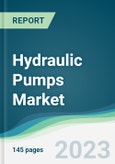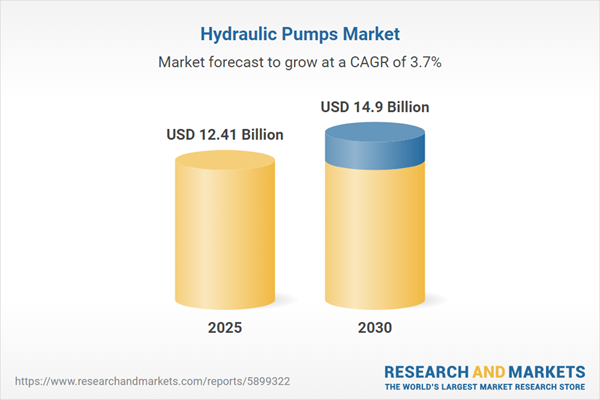The hydraulic pumps market is anticipated to expand at a CAGR of 3.72% over the forecast period, increasing from US$12.409 billion in 2025 to US$14.897 billion by 2030.
A hydraulic pump is a machine by which mechanical energy is converted into hydraulic energy, which generates flow with sufficient pressure to overcome load resistance within the hydraulic system. Generally, the parts consist of an inlet port, outlet port, pumping element, and drive shaft. Various types of hydraulic pumps include gear pumps, vane pumps, and piston pumps. Their applications range from construction equipment to automotive as well as aerospace industries and the manufacturing industry.
Heavy machinery that makes use of hydraulic pumps is one of those areas that has created much demand in developing economies, such as China and India, due to increased industrialization and urbanization. As per UNTAD data, the increasing trend in urban population, which was valued at 4.54 billion in 2022, will keep growing to reach a population of 6.60 billion in 2050. Excavation, drilling, and material handling are therefore highly reliant on hydraulic-powered equipment used in the mining and construction industries for increasing demand for the exploration of natural resources and the construction of infrastructure
In addition, investments by governments worldwide in infrastructure projects like roads, bridges, and buildings are contributing to market expansion because they are critical components in construction machinery.
The hydraulic pump market is incrementing mainly due to rising demands in infrastructure activity for various applications from the construction, civil engineering, mining, renewable energy, and aerospace industries for heavy machinery and equipment. Valuable infrastructure sectors such as construction, mining, and renewable energy are driving the increasing demands. As per the U.S. Census Bureau data, as of November 2024, there was an increase in construction spending in the USA from US$2055.2 in September 2023 to US$2,148.8 in September 2024.
Moreover, growing urbanization, industrialization, and increasing government investment toward infrastructure projects are increasing globally. Further, since the use of digital technologies and automation are yielding increased demand for hydraulic pumps in automated systems, the trend will grow during the projected period.
One of the primary drivers for this market's growth is the ongoing boom in infrastructure development across the U.S. The government's commitment to enhancing infrastructure through substantial investments has led to a surge in construction projects. Hydraulic pumps are essential components in heavy machinery, including excavators, cranes, and bulldozers, vital for executing large-scale construction tasks.
Additionally, the automotive sector is also contributing significantly to the demand for hydraulic pumps. As vehicle production ramps up, especially with the rise of EVs, the need for hydraulic systems in applications such as power steering and braking becomes increasingly important. In this regard, according to the International Energy Agency, in 2023, the United States witnessed an increase in its electric car registrations, which came out to be 1.4 million in 2023, increasing by more than 40% compared to 2022.
Furthermore, substantial investments in the energy sector, particularly in renewable energy and power generation, are fueling demand for hydraulic pumps. The U.S. government has announced significant funding aimed at enhancing power generation capabilities, including upgrading existing hydraulic systems for improved efficiency and reliability. Additionally, strategic developments are also playing a crucial role in driving the market's growth. For instance, in June 2023, SPX FLOW, Inc. released the new PE60 Series hydraulic pump, designed for versatility and usability. This pump offers increased control technology, auto-cycle functionality, longer runtime, and "plug and play" accessories. It is suitable for high-pressure bolting tool applications like power generation, machinery maintenance, construction, and utility. The pump is designed for torquing applications and features a hand-control pendant design for operator comfort, reducing fatigue, and allowing long-term pump control.
A hydraulic pump is a machine by which mechanical energy is converted into hydraulic energy, which generates flow with sufficient pressure to overcome load resistance within the hydraulic system. Generally, the parts consist of an inlet port, outlet port, pumping element, and drive shaft. Various types of hydraulic pumps include gear pumps, vane pumps, and piston pumps. Their applications range from construction equipment to automotive as well as aerospace industries and the manufacturing industry.
Heavy machinery that makes use of hydraulic pumps is one of those areas that has created much demand in developing economies, such as China and India, due to increased industrialization and urbanization. As per UNTAD data, the increasing trend in urban population, which was valued at 4.54 billion in 2022, will keep growing to reach a population of 6.60 billion in 2050. Excavation, drilling, and material handling are therefore highly reliant on hydraulic-powered equipment used in the mining and construction industries for increasing demand for the exploration of natural resources and the construction of infrastructure
In addition, investments by governments worldwide in infrastructure projects like roads, bridges, and buildings are contributing to market expansion because they are critical components in construction machinery.
Hydraulic pump market drivers
The growing businesses worldwide are predicted to promote the hydraulic pump market expansion.The hydraulic pump market is incrementing mainly due to rising demands in infrastructure activity for various applications from the construction, civil engineering, mining, renewable energy, and aerospace industries for heavy machinery and equipment. Valuable infrastructure sectors such as construction, mining, and renewable energy are driving the increasing demands. As per the U.S. Census Bureau data, as of November 2024, there was an increase in construction spending in the USA from US$2055.2 in September 2023 to US$2,148.8 in September 2024.
Moreover, growing urbanization, industrialization, and increasing government investment toward infrastructure projects are increasing globally. Further, since the use of digital technologies and automation are yielding increased demand for hydraulic pumps in automated systems, the trend will grow during the projected period.
Hydraulic pump market geographical outlook
Based on geography, the hydraulic pumps market is segmented into North America, South America, Europe, the Middle East and Africa, and the Asia-Pacific.The United States held a considerable market share in the North American region. The hydraulic pump market in the United States will increase rapidly owing to several factors, such as the expansion of key sectors such as construction, automotive, and energy production. The increasing demand for hydraulic pumps is attributed to their critical role in powering heavy machinery and equipment used across various applications, making them indispensable in modern industrial operations.One of the primary drivers for this market's growth is the ongoing boom in infrastructure development across the U.S. The government's commitment to enhancing infrastructure through substantial investments has led to a surge in construction projects. Hydraulic pumps are essential components in heavy machinery, including excavators, cranes, and bulldozers, vital for executing large-scale construction tasks.
Additionally, the automotive sector is also contributing significantly to the demand for hydraulic pumps. As vehicle production ramps up, especially with the rise of EVs, the need for hydraulic systems in applications such as power steering and braking becomes increasingly important. In this regard, according to the International Energy Agency, in 2023, the United States witnessed an increase in its electric car registrations, which came out to be 1.4 million in 2023, increasing by more than 40% compared to 2022.
Furthermore, substantial investments in the energy sector, particularly in renewable energy and power generation, are fueling demand for hydraulic pumps. The U.S. government has announced significant funding aimed at enhancing power generation capabilities, including upgrading existing hydraulic systems for improved efficiency and reliability. Additionally, strategic developments are also playing a crucial role in driving the market's growth. For instance, in June 2023, SPX FLOW, Inc. released the new PE60 Series hydraulic pump, designed for versatility and usability. This pump offers increased control technology, auto-cycle functionality, longer runtime, and "plug and play" accessories. It is suitable for high-pressure bolting tool applications like power generation, machinery maintenance, construction, and utility. The pump is designed for torquing applications and features a hand-control pendant design for operator comfort, reducing fatigue, and allowing long-term pump control.
Reasons for buying this report:
- Insightful Analysis: Gain detailed market insights covering major as well as emerging geographical regions, focusing on customer segments, government policies and socio-economic factors, consumer preferences, industry verticals, other sub-segments.
- Competitive Landscape: Understand the strategic maneuvers employed by key players globally to understand possible market penetration with the correct strategy.
- Market Drivers & Future Trends: Explore the dynamic factors and pivotal market trends and how they will shape up future market developments.
- Actionable Recommendations: Utilize the insights to exercise strategic decision to uncover new business streams and revenues in a dynamic environment.
- Caters to a Wide Audience: Beneficial and cost-effective for startups, research institutions, consultants, SMEs, and large enterprises.
What do businesses use our reports for?
Industry and Market Insights, Opportunity Assessment, Product Demand Forecasting, Market Entry Strategy, Geographical Expansion, Capital Investment Decisions, Regulatory Framework & Implications, New Product Development, Competitive IntelligenceReport Coverage:
- Historical data & forecasts from 2022 to 2030
- Growth Opportunities, Challenges, Supply Chain Outlook, Regulatory Framework, Customer Behaviour, and Trend Analysis
- Competitive Positioning, Strategies, and Market Share Analysis
- Revenue Growth and Forecast Assessment of segments and regions including countries
- Company Profiling (Strategies, Products, Financial Information, and Key Developments among others)
The hydraulic pumps market is analyzed into the following segments:
By Type
- Gear Pump
- Piston Pump
- Vane Pump
- Screw Pump
- Others
By Material
- Aluminium
- Stainless Steel
By End-User
- Aerospace & Defense
- Industrial
- Automotive
- Water Treatment
- Construction
- Other
By Geography
- North America
- South America
- Europe
- Middle East and Africa
- Asia-Pacific
Table of Contents
1. INTRODUCTION
2. RESEARCH METHODOLOGY
3. EXECUTIVE SUMMARY
4. MARKET DYNAMICS
5. HYDRAULIC PUMPS MARKET BY TYPE
6. HYDRAULIC PUMPS MARKET BY MATERIAL
7. HYDRAULIC PUMPS MARKET BY END-USER
8. HYDRAULIC PUMPS MARKET BY GEOGRAPHY
9. COMPETITIVE ENVIRONMENT AND ANALYSIS
10. COMPANY PROFILES
Companies Mentioned
- Bosch Rexroth
- Danfoss
- Eaton Corporation
- Hydraulic & Pneumatic Products
- Kawasaki Heavy Industries, Ltd.
- Nabtesco Motion Control, Inc.
- Panagon Systems, Inc.
- PARKER HANNIFIN CORP
- Poclain
- Yeoshe Hydraulics Technology Co. Ltd.
- Yuken Kogyo
Methodology

LOADING...
Table Information
| Report Attribute | Details |
|---|---|
| No. of Pages | 145 |
| Published | December 2024 |
| Forecast Period | 2025 - 2030 |
| Estimated Market Value ( USD | $ 12.41 Billion |
| Forecasted Market Value ( USD | $ 14.9 Billion |
| Compound Annual Growth Rate | 3.7% |
| Regions Covered | Global |
| No. of Companies Mentioned | 11 |









